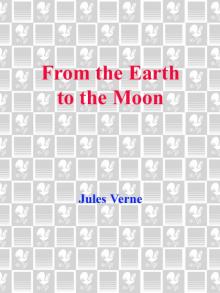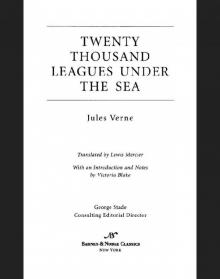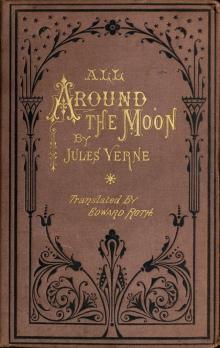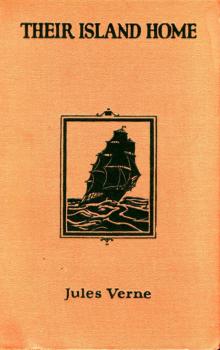- Home
- Jules Verne
From the Earth to the Moon Page 7
From the Earth to the Moon Read online
Page 7
It is generally known and often repeated that gunpowder was invented in the fourteenth century by a monk named Schwarz, who paid for his great discovery with his life. But it has now been almost certainly proven that this story must be classified as a medieval legend. Gunpowder was invented by no one. It is directly descended from “Greek fire,” which, like it, is composed of sulfur and saltpeter; but in the course of time those deflagrating mixtures were transformed into explosive ones.
But while the learned are perfectly familiar with the false history of gunpowder, few people realize its mechanical power. This must be known in order to understand the importance of the question under consideration by the committee.
A quart of gunpowder weighs about two pounds. When it burns, it produces 400 quarts of gas. When this gas is released, under the effect of a temperature of 2,400 degrees, it occupies a volume of 4,000 quarts. Thus the ratio between a certain volume of gunpowder and the volume of gas it produces when it burns is 4,000 to one. It is not difficult to imagine the awesome power of that gas when it is confined in a space 4,000 times too small for it.
The members of the committee were well aware of this when they began their third meeting. Barbicane gave the floor to Major Elphiston, who had been in charge of powder production during the war.
“Gentlemen,” said the distinguished chemist, “I’ll begin by giving you some undeniable figures that we can use as a basis for discussion. The twenty-four-pounder, which our honorable secretary spoke about so poetically the day before yesterday, uses only sixteen pounds of powder to fire its ball.”
“Are you sure of that figure?” asked Barbicane.
“Quite sure. The Armstrong cannon uses only seventy-five pounds of powder for its 800-pound projectile, and the Rodman Columbiad uses only 160 pounds of powder to shoot its half-ton projectile a distance of six miles. These facts are incontestable, because I personally gathered them from the reports of the Artillery Committee.”
“That’s perfectly true,” said the general.
“Here’s the conclusion to be drawn from these figures,” said the major: “the quantity of powder doesn’t increase in direct proportion to the weight of the projectile. The twenty-four-pounder uses sixteen pounds of powder, or two-thirds the weight of its projectile, but that ratio isn’t constant.
“If it were, a projectile weighing half a ton would require 667 pounds of powder, but it actually requires only 160 pounds.”
“What point are you trying to make?” asked Barbicane.
“If you carry your theory to its logical conclusion, Major,” said J. T. Maston, “you’ll have to maintain that when the projectile becomes heavy enough, it won’t need any powder at all!”
“You’re playful even in the midst of a serious discussion, Maston,” said the major, “but don’t worry: I’ll soon propose a quantity of powder that will satisfy your honor as an artilleryman. I do want to point out, however, that after experiments made during the war the powder charge for the biggest cannons was reduced to a tenth of the weight of their projectiles.”
“That’s also perfectly true,” said the general. “But before we decide on the amount of powder necessary to propel our projectile, I think we’d better agree on what kind of powder we’ll use.”
“We’ll use coarse-grained powder,” said the major. “It burns faster than fine-grained powder.”
“Yes,” said the general, “but it has a high degree of brisance and eventually damages a gun’s bore.”
“That’s a drawback for a cannon meant for long use, but not for our Columbiad. We’ll run no risk of a burst barrel, and the powder will have to ignite very quickly, so that its energy will be completely utilized.”
“We could make several priming holes,” said J. T. Maston, “and ignite the powder at different places simultaneously.”
“I suppose so,” replied the major, “but that would make the operation more difficult. I’ll stick to my coarse-grained powder because it will eliminate such difficulties.”
“So be it,” said the general.
“In his Columbiad,” said the major, “Rodman used a powder with grains the size of chestnuts, made of willow charcoal that was simply roasted in iron boilers. It was hard and glossy, left no trace on the hand, contained a high proportion of hydrogen and oxygen, burned instantaneously, and, despite its great brisance, it wasn’t hard on gun barrels.”
“Then I don’t see any reason to hesitate,” said J. T. Maston. “Our choice is clear.”
“Unless you’d prefer gold powder,” said the major, laughing. This earned him a threatening gesture from his touchy friend’s iron hook.
So far Barbicane had remained aloof from the discussion. He had been merely listening and letting the others talk. It was obvious that he had an idea. He contented himself with saying:
“And now, my friends, what quantity of powder do you propose?”
His three colleagues looked at one another for a few moments. Finally the general said, “Two hundred thousand pounds.”
“Five hundred thousand,” said the major.
“Eight hundred thousand pounds!” said J. T. Maston.
This time the major could not accuse him of exaggerating. After all, they were planning to send a 20,000-pound projectile to the moon with an initial velocity of 36,000 feet per second. There was a silence after the three men had made their respective proposals.
It was finally broken by Barbicane:
“Gentlemen,” he said calmly, “I start from the principle that the strength of our cannon, built correctly, will be unlimited. I’m therefore going to surprise Mr. Maston by proposing to double his 800,000 pounds of powder.”
“A million six hundred thousand pounds?” said J. T. Maston, bounding on his chair.
“Yes.”
“But then we’ll have to come back to my half-mile cannon!”
“That’s obvious,” said the major.
“A million six hundred thousand pounds of powder,” said J. T. Maston, “will occupy a volume of about 22,000 cubic feet. Since your cannon has a capacity of only 54,000 cubic feet, it will be half full, and the bore will be so short that the expanding gases won’t be able to give the projectile enough velocity.”
There was no answer to that. J. T. Maston had spoken the truth. They all looked at Barbicane.
“Nevertheless,” he said, “I insist on using that much powder. Think of it: 1,600,000 pounds of powder will produce 2,500,000 cubic feet of gas. Two and a half million! Do you realize what that means?”
“But how can we do it?” asked the general.
“It’s quite simple: we must reduce that enormous mass of powder without diminishing its power.”
“Very well, but how?”
“I’ll tell you,” Barbicane said simply. The others stared at him eagerly. “Nothing could be simpler than to reduce that amount of powder to a quarter of its normal volume. You’re all familiar with that singular substance which forms the elementary tissues of plants and is known as cellulose.”
“Ah, now I understand you!” said the major.
“It can be obtained in a pure state from various sources,” Barbicane went on, “especially cotton, which is the fiber that surrounds the seeds of the cotton plant. When cotton is combined with cold nitric acid, it’s transformed into a substance that’s extremely insoluble, combustible, and explosive. It was discovered over thirty years ago, in 1832, by a French chemist named Braconnot. He called it xyloïdine. In 1838 another Frenchman, Pelouze, studied its various properties, and in 1846 Schönbein, a chemistry professor in Basel, proposed that it be used as gunpowder. That powder is known as guncotton.”
“Or pyroxylin,” said the major.
“Or nitrocellulose,” said the general.
“Wasn’t there at least one American involved in the discovery?” asked J. T. Maston, moved by a keen feeling of national pride.
“Not a single one, unfortunately,” said the major.
“If it will make you feel better,�
� said Barbicane, “I’ll tell you that one American’s work is important in the study of cellulose, because collodion, one of the main agents in photography, is simply pyroxylin dissolved in alcohol and ether, and it was discovered by Maynard, who was a medical student in Boston at the time.”
“Hurrah for Maynard and pyroxylin!” cried the noisy secretary of the Gun Club.
“To return to guncotton,” said Barbicane, “you all know the properties that will make it so valuable to us. It can be made very easily: you soak cotton in nitric acid for fifteen minutes, rinse it with water, let it dry, and that’s all.”
“What could be simpler?” said the general.
“Furthermore, guncotton is unaffected by humidity. That’s a valuable quality for our purposes, since it will take several days to load the cannon. It ignites at 160 degrees centigrade instead of 240, and it burns so quickly that if it’s placed on top of a charge of ordinary powder and ignited, the ordinary powder won’t have time to catch fire.”
“It sounds perfect,” said the major.
“However, it’s very expensive.”
“What does that matter?” said J. T. Maston.
“Finally, it can fire a projectile four times faster than ordinary powder can. And if it’s mixed with a quantity of potassium nitrate equal to eighty percent of its weight, its power is increased still more.”
“Will that be necessary?” asked the major.
“I don’t think so,” replied Barbicane. “So instead of 1,600,000 pounds of powder, we’ll have only 400,000 pounds of guncotton. Since 500 pounds of it can safely be compressed into a volume of twenty-seven cubic feet, the whole charge will take up only 180 feet of the cannon’s length, and the 2,500,000 cubic feet of gas will drive the shell through more than 700 feet of bore before sending it on its way toward the moon.”
At these eloquent words, J. T. Maston was unable to contain his emotion: he threw himself into his friend’s arms with the force of a cannon ball, and would have knocked him flat if Barbicane had not been built to withstand the most violent bombardment.
This incident ended the third meeting of the committee. Barbicane and his daring colleagues, to whom nothing seemed impossible, had just settled the complex questions of the projectile, the cannon, and the powder. Their plan was decided upon; they now had only to carry it out.
“That’s only a detail, a mere trifle,” said J. T. Maston.
Note: In the course of the above discussion, Barbicane credits one of his compatriots with the invention of collodion. This is a mistake, with all due deference to J. T. Maston, and it has arisen from the similarity between two names.
It is true that in 1847 Maynard, then a Boston medical student, had the idea of using collodion in the treatment of wounds, but collodion was already known in 1846. The honor of that great discovery must go to a Frenchman, a distinguished mind, a chemist who is also a painter, a poet, a philosopher, and a Hellenist: M. Louis Ménard.
CHAPTER 10
ONE ENEMY AMONG TWENTY-FIVE MILLION FRIENDS
THE AMERICAN public took great interest in every detail of the Gun Club’s project. They followed the committee’s discussions day by day. They were fascinated by the simplest preparations for the great experiment, the questions of figures that it raised, the mechanical difficulties that would have to be overcome—in short, the whole process of getting the operation under way.
More than a year was to pass between the beginning of the work and its completion, but that time would not be devoid of excitement. The site to be chosen for the hole in the ground, the construction of the mold, the casting of the cannon, its highly dangerous loading: these things were more than enough to arouse the public’s curiosity. When the projectile was fired, it would be out of sight in a few tenths of a second; from then on, only a privileged few would be able to see what would become of it, how it would behave in space, and how it would reach the moon. For this reason, the main interest lay in the preparations for the experiment and the precise details of its execution.
But to its purely scientific interest was suddenly added the commotion stirred up by an incident.
We have already seen how many friends and admirers Barbicane’s project had attracted to him. Honorable and extraordinary though it was, however, this majority was not unanimous. One man in all the states of the Union protested against the project. He attacked it violently at every opportunity, and human nature is so made that Barbicane was more strongly affected by that one man’s opposition than he was by the applause of all the others.
Yet he well knew the motive of that antipathy, the source of that solitary enmity, why it was personal and of long standing, and the rancorous rivalry that had produced it.
He had never seen that determined enemy. This was fortunate, for an encounter between the two men would certainly have had regrettable consequences. That rival was a scientist like Barbicane, a proud, dauntless, earnest, violent man, a pure Yankee. His name was Captain Nicholl. He lived in Philadelphia.
Everyone knows of the strange struggle that took place during the Civil War between cannons and naval armor, with the former determined to pierce the latter, and the latter determined to withstand the former. It led to radical changes in the navies of both continents. Projectiles and armor plate fought relentlessly; the first constantly grew larger as the second grew thicker. Ships armed with formidable guns moved into battle beneath the protection of their invulnerable iron shells. Vessels such as the Merrimac, the Monitor and the Weehawken fired enormous projectiles after armoring themselves against those of the enemy. They did unto others as they would not have had others do unto them, an immoral principle on which the whole art of war is based.
Barbicane was a great caster of projectiles, and Nicholl was a great forger of armor. One cast night and day in Baltimore, while the other forged day and night in Philadelphia. Each was pursuing a line of thought essentially opposed to that of the other.
As soon as Barbicane invented a new projectile, Nicholl invented a new armor plate. Barbicane spent all his time making holes, Nicholl in preventing him from doing so—hence a constant rivalry that soon became personal. Nicholl appeared in Barbicane’s dreams as an impenetrable armor plate which he crashed into at high speed, and Barbicane appeared in Nicholl’s dreams as a projectile that cut him in half.
Although they were following divergent lines, the two scientists would eventually have encountered each other, despite all the axioms of geometry—but it would have been on the field of honor. Fortunately for these citizens so useful to their country, they were separated by a distance of fifty or sixty miles, and their friends placed so many obstacles along the way that they never met.
It was not clear which of the two inventors had gotten the better of the other; the results obtained made it difficult to form a precise judgment. It seemed, however, that in the long run the armor plate would have to yield to the projectile.
Nevertheless there were competent men who had their doubts. In a recent test, Barbicane’s cylindro-conical projectiles had stuck in Nicholl’s armor like pins. Nicholl had considered himself victorious and displayed unbounded contempt for his rival. But when Barbicane later replaced his conical projectiles with ordinary 600-pound shells, the captain had to change his tune. Although they had only a moderate velocity,* these projectiles pierced, cracked, and shattered the best armor plate.
Things had reached this point, with victory apparently won by the projectile, when the war ended on the very day that Nicholl finished his new forged steel armor! It was a masterpiece of its kind; it would defy all the projectiles in the world. Nicholl had it taken to the experimental range in Washington and challenged Barbicane to pierce it. But now that the war was over, Barbicane did not want to make the test.
Captain Nicholl, infuriated, offered to expose his armor to projectiles of every conceivable kind: solid, hollow, round, or conical. He met with another refusal from Barbicane, who was apparently determined not to jeopardize the victory he had won.
> Thrown into a frenzy by this unspeakable obstinacy, Nicholl tried to tempt Barbicane by making the conditions as favorable for him as possible. He offered to put his armor only two hundred yards from the cannon. Barbicane maintained his stubborn refusal. A hundred yards? No, not even at seventy-five.
“Fifty yards, then!” Nicholl said through the medium of the newspapers. “Or I’m even willing to put my armor only twenty-five yards away, and I’ll stand behind it!”
Barbicane answered that even if Captain Nicholl stood in front of it, he still would not shoot.
Nicholl could no longer restrain himself when he learned of this reply. He made some personal remarks. He said that cowardice was cowardice, no matter what form it took; that a man who refused to fire a cannon was very close to being afraid to do it; that the artillerymen who now fought at a distance of six miles had prudently replaced individual courage with mathematical formulas; and that, furthermore, it took as much bravery to wait calmly for a cannon ball behind a sheet of armor as it did to shoot one under all the proper conditions.
Barbicane made no reply to these insinuations; he may not even have known about them, for he was then completely absorbed in making plans for his great undertaking.
When Barbicane made his famous speech to the Gun Club, Captain Nicholl’s anger reached its peak. It was mingled with supreme jealousy and a feeling of absolute impotence. How could he possibly invent something better than that 900-foot cannon? What armor could ever withstand a 20,000-pound projectile? At first he was staggered, overwhelmed, stunned by that cruel blow. Then he recovered his strength and resolved to crush the project beneath the weight of his arguments. He violently attacked the work of the Gun Club. He wrote a number of letters which the newspapers did not refuse to print. He tried to demolish Barbicane’s plans scientifically. Once he had declared war, he resorted to all kinds of arguments, and it must be said that all too often they were specious and ungentlemanly.

 Michael Strogoff; Or the Courier of the Czar: A Literary Classic
Michael Strogoff; Or the Courier of the Czar: A Literary Classic Voyage au centre de la terre. English
Voyage au centre de la terre. English Journey Through the Impossible
Journey Through the Impossible The Castaways of the Flag
The Castaways of the Flag L'île mystérieuse. English
L'île mystérieuse. English Maître du monde. English
Maître du monde. English Around the World in Eighty Days
Around the World in Eighty Days A Voyage in a Balloon
A Voyage in a Balloon From the Earth to the Moon, Direct in Ninety-Seven Hours and Twenty Minutes: and a Trip Round It
From the Earth to the Moon, Direct in Ninety-Seven Hours and Twenty Minutes: and a Trip Round It Paris in the Twentieth Century
Paris in the Twentieth Century City in the Sahara - Barsac Mission 02
City in the Sahara - Barsac Mission 02 The English at the North Pole
The English at the North Pole The Field of Ice
The Field of Ice From the Earth to the Moon
From the Earth to the Moon Un capitaine de quinze ans. English
Un capitaine de quinze ans. English The Mysterious Island
The Mysterious Island Les indes-noirs. English
Les indes-noirs. English Robur-le-conquerant. English
Robur-le-conquerant. English Propeller Island
Propeller Island Around the World in Eighty Days. Junior Deluxe Edition
Around the World in Eighty Days. Junior Deluxe Edition Les forceurs de blocus. English
Les forceurs de blocus. English In the Year 2889
In the Year 2889 Journey to the Centre of the Earth
Journey to the Centre of the Earth Twenty Thousand Leagues Under the Sea
Twenty Thousand Leagues Under the Sea From the Earth to the Moon; and, Round the Moon
From the Earth to the Moon; and, Round the Moon Vingt mille lieues sous les mers. English
Vingt mille lieues sous les mers. English Cinq semaines en ballon. English
Cinq semaines en ballon. English Twenty Thousand Leagues under the Seas
Twenty Thousand Leagues under the Seas Face au drapeau. English
Face au drapeau. English Michael Strogoff; Or, The Courier of the Czar
Michael Strogoff; Or, The Courier of the Czar Un billet de loterie. English
Un billet de loterie. English The Secret of the Island
The Secret of the Island Off on a Comet! a Journey through Planetary Space
Off on a Comet! a Journey through Planetary Space Into the Niger Bend: Barsac Mission, Part 1
Into the Niger Bend: Barsac Mission, Part 1 All Around the Moon
All Around the Moon A Journey to the Center of the Earth - Jules Verne: Annotated
A Journey to the Center of the Earth - Jules Verne: Annotated 20000 Lieues sous les mers Part 2
20000 Lieues sous les mers Part 2 Robur-le-Conquerant
Robur-le-Conquerant Les Index Noires
Les Index Noires Michael Strogoff; or the Courier of the Czar
Michael Strogoff; or the Courier of the Czar 20000 Lieues sous les mers Part 1
20000 Lieues sous les mers Part 1 Twenty Thousand Leagues Under the Sea (Barnes & Noble Classics Series)
Twenty Thousand Leagues Under the Sea (Barnes & Noble Classics Series) Five Weeks In A Balloon
Five Weeks In A Balloon Journey to the Center of the Earth
Journey to the Center of the Earth 20,000 Leagues Under the Sea
20,000 Leagues Under the Sea Journey to the Center of the Earth (Barnes & Noble Classics Series)
Journey to the Center of the Earth (Barnes & Noble Classics Series) Adrift in the Pacific-Two Years Holiday
Adrift in the Pacific-Two Years Holiday The Collected Works of Jules Verne: 36 Novels and Short Stories (Unexpurgated Edition) (Halcyon Classics)
The Collected Works of Jules Verne: 36 Novels and Short Stories (Unexpurgated Edition) (Halcyon Classics) The Survivors of the Chancellor
The Survivors of the Chancellor Their Island Home
Their Island Home Le Chateau des Carpathes
Le Chateau des Carpathes Les Cinq Cents Millions de la Begum
Les Cinq Cents Millions de la Begum The Floating Island
The Floating Island Cinq Semaines En Ballon
Cinq Semaines En Ballon Autour de la Lune
Autour de la Lune